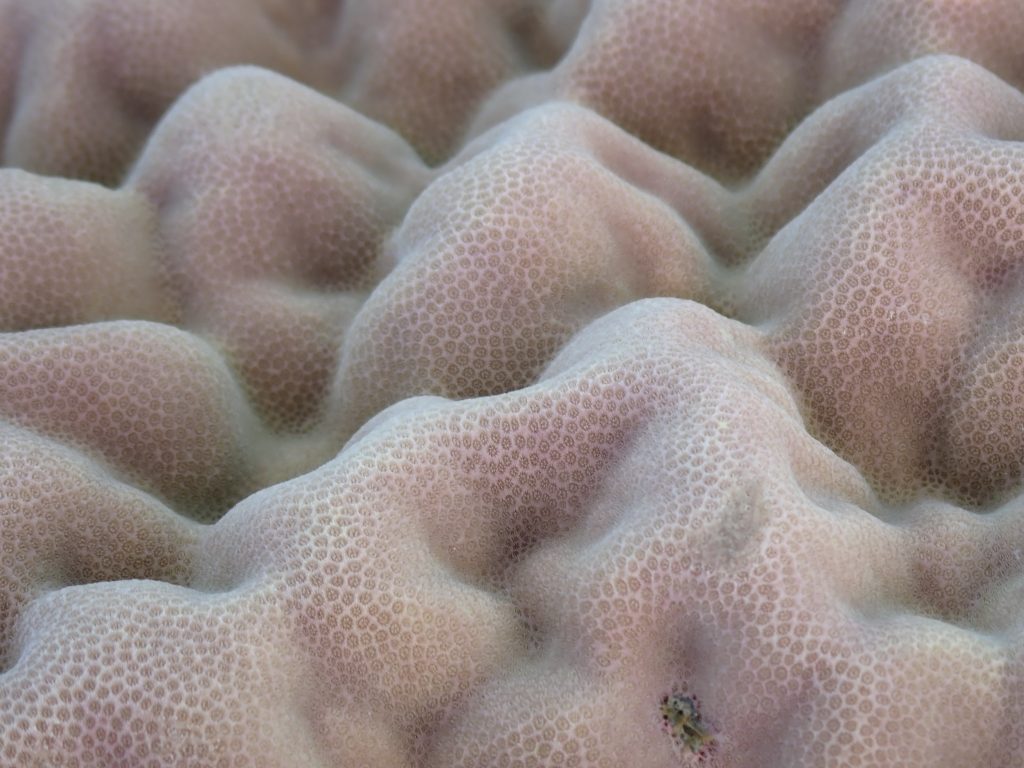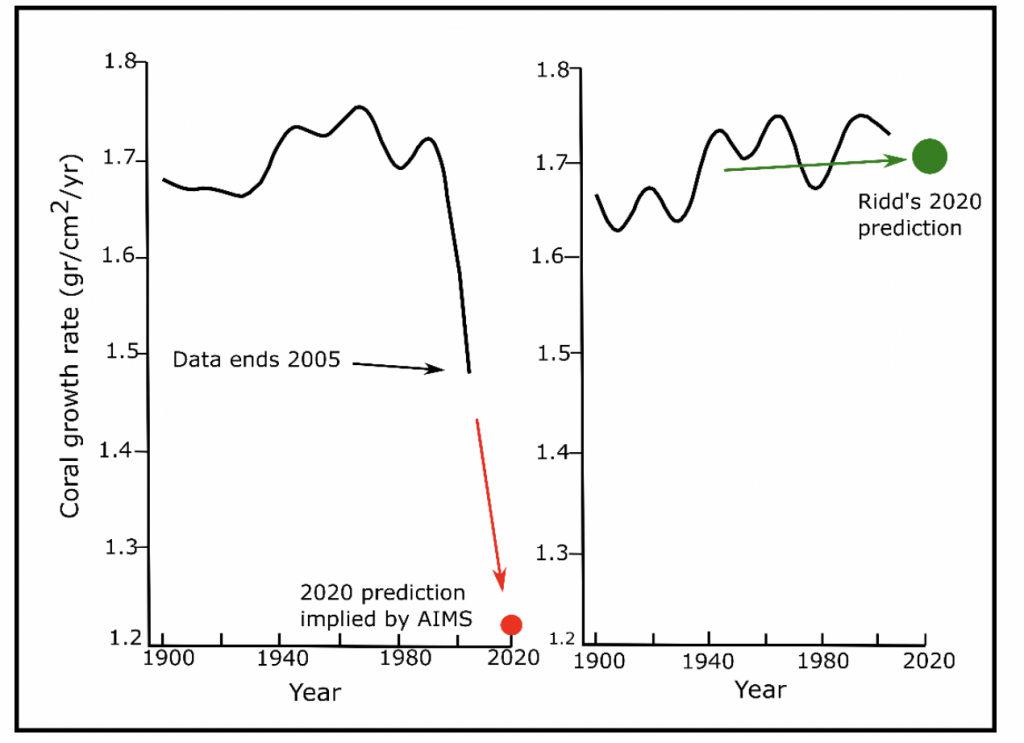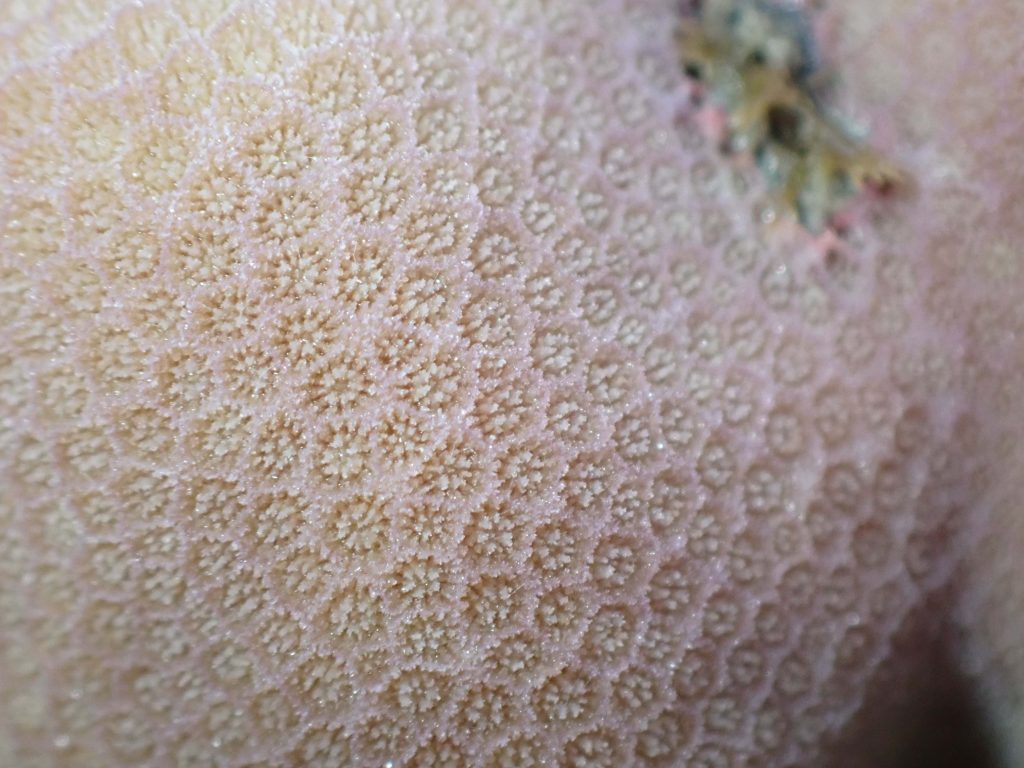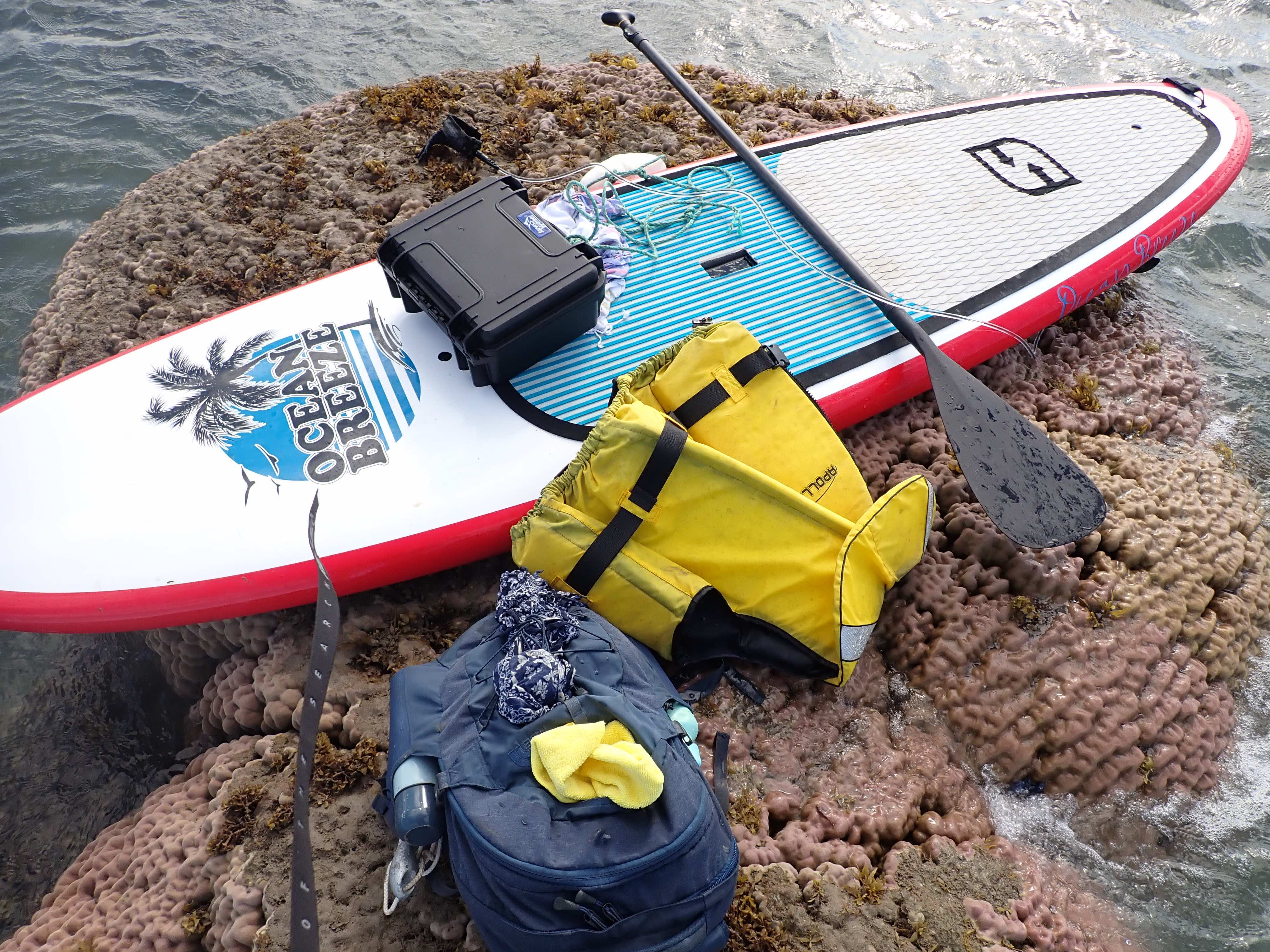CORALS are animals, closely related to jelly fish, but they differ in having a limestone skeleton. This is hard-stuff, calcium carbonate, and it can persist in the environment and provide an indication of changes in sea level, and also the growth rates of corals, over thousands of years.

There are well established techniques for coring corals, and then measuring growth rates. But as Peter Ridd explains in the following article just published by The Australian, since 2005 there has been no systematic study* of coral growth rates at the Great Barrier Reef.
It is the case that lots of claims are made about declining calcification rates and also declining water quality. But the data is either missing or could actually tell quite a different story.
This is the first in a series of blog posts planned on what Peter is calling ‘The Coral Challenge’. Graham Lloyd has a companion piece, also in today’s The Australian.
Great Barrier Reef Truth May Be Inconvenient, But It Is Out There
By Dr Peter Ridd
We have no data of Great Barrier Reef coral growth rates for the last 15 years. Has growth collapsed as the Australian Institute of Marine Science claims?
Is the Great Barrier Reef (GBR) being affected by climate change, the acidification of the ocean, and the pesticides, sediment and fertiliser from farms? One way to tell is to measure the coral growth rates. Our science institutions claim that coral growth rates collapsed between 1990 and 2005 due to stress from human pollution. Remarkably, despite having data of coral growth rates for the last few centuries, there is no data for the last 15 years. We don’t know how the GBR has fared since 2005.
Corals have yearly growth rings similar to tree rings. By drilling cores from large corals, scientists can measure the growth rates over the life of the coral. The yearly rings are roughly 10 millimetres thick so a coral that is many meters across can be hundreds of years old. In a landmark study, the Australian Institute of Maine Science (AIMS) took cores from over 300 corals on the GBR and concluded that for the last three hundred years, coral growth was stable, but in 1990 there was an unprecedented and dramatic collapse of 15%.
With Thomas Stieglitz and Eduardo da Silva, I reanalysed the AIMS data and, in our opinion, AIMS made two major mistakes. The first was incorrect measurement of the near surface coral growth rings on most of the corals that were giving data from 1990 to 2005. After years of argument AIMS have begrudgingly agreed that they made this mistake. The other problems is that they used much smaller and younger corals for the 1990-2005 data compared with the mostly very large and old corals of the pre 1990 data: they changed their methodology and this is what caused the apparent drop at 1990. When we corrected this problem, the fall in growth rate disappeared.
AIMS continue to dispute this second error and still claim there was a worrying reduction in growth rate between 1990 to 2005. This disputed work is quoted in influential government documents such as the 2019 reef outlook report. I am not cherry-picking a minor problem. It is a fundamental problem with a keystone piece of GBR science.
We thus have a situation that arguably the most important data that tells us about the health of the GBR is highly questionable from 1990 to 2005.
What is far worse is that we have no data whatever since 2005.
The science institutions have not only failed to investigate probable major errors in their work, they have also failed to update measurement of this fundamental parameter while claiming, in increasingly shrill tones, that the GBR is in peril.
But ironically, this failure provides a fantastic opportunity: The Coral Challenge.
For the last 15 years we don’t know what growth rates have been. It is easy to fill in the missing data, and check the previous data, by taking more cores from the reef. AIMS have effectively stated that coral growth is falling at 1% per year. According to the AIMS curve, growth should now be 30% lower than it was in 1990 – a disastrous fall.
I predict it has stayed the same. Either way, it would be nice to know what has actually happened – is the reef really in danger or not?

Science is a method. The best test of competing theories, hypotheses and claims is with the data.
But a second and almost equally valuable outcome of measuring the missing data is that it will be an acid test of the trustworthiness of our major science institutions. AIMS have dug in their heels and denied they made a major methodological mistake. Let’s do the experiment and see if they are right, or untrustworthy. Same for me. If this measurement is done, and done properly, and it shows there has been a major reduction in coral growth rates, I will be the first to accept I was wrong and that there is a disaster happening on the reef.
The coral challenge is a measurement that will have to be done sooner or later. The longer it is neglected the worse it will look to the public. Farmers who are accused of killing the reef are especially interested.
We need to make sure these new measurements are done properly and without any questions about reliability. They must be supervised by a group of scientists that are acceptable to both sides of the agricultural debate on the reef to ensure methodology and execution is impeccable.
End of article by Dr Ridd.
___
*There have been some recent studies of calcification rates at a limited number of sites, and these contradict the media headlines and the landmark AIMS study. For example:
‘Long-term growth trends of massive Porites corals across a latitudinal gradient in the Indo-Pacific’ by Tries B. Razak, George Roff, Janice M. Lough, Dudi Prayudi, Neal E. Cantin, Peter J. Mumby in Marine Ecology Progress Series, Volume 626. The Abstract reads:
“Previous studies have reported recent substantial declines in the growth rates of massive Porites corals under warming oceans. However, the majority of these reports are from inshore reefs, and few have explored growth responses in offshore reefs from remote locations with low levels of pollution, sedimentation or nutrient loading. Here, we examined continuous growth records of massive Porites from remote locations spanning a 25° latitudinal gradient in the Indo-Pacific, including Palau, central Sulawesi, West Papua and the central Great Barrier Reef (GBR). Between 1982 and 2012, no significant changes in calcification or extension anomalies were observed at any study location, despite significant increases in sea surface temperature (SST) at all sites. Skeletal density increased linearly by ~0.4% yr−1 in Palau, but no change was found in Sulawesi, yet skeletal density showed a significant nonlinear change in West Papua and the GBR. Skeletal density displayed a significant positive linear relationship with SST at Palau and West Papua, whereas no relationship was observed in Sulawesi. In the GBR, skeletal density exhibited a nonlinear parabolic relationship with SST, with strong negative anomalies occurring following major thermal events. Unlike the ongoing declines in growth rates of inshore corals that have been widely reported, we found that calcification and extension anomalies of the majority of Porites from offshore remote locations do not appear to be exhibiting negative growth responses to warming SST. Our results suggest that reefs experiencing low levels of local stressors may show increased resilience to warming SST in an era of rapidly warming oceans.
Further Reading
There is more background information on Peter Ridd’s work in this area in the book that I edited: ‘Climate Change: The Facts 2017’, specifically the chapter entitled: ‘The Extraordinary Resilience of Great Barrier Reef Corals, And Problems with Policy Science’. Go have a read!

The coral featured at the top of this blog post is a huge Porites, perhaps 1,000 years old, that the experts claim does not exist because they deny the inshore reefs off-Bowen. I rested on it, while exploring south of Bowen in August 2019 with my paddle board. The black case (the Jarvis Walker) is for my drone Skido, who comes with me paddle boarding.


 Jennifer Marohasy BSc PhD is a critical thinker with expertise in the scientific method.
Jennifer Marohasy BSc PhD is a critical thinker with expertise in the scientific method.

With any attached organism growth and longevity is affected by location, with older larger individuals being found in more favourable locations. If the AIMS study did not take care to obtain the younger smaller specimens used for their most recent growth rates from locations immediately adjacent to the older larger ones they would have been likely to include ones from less favourable locations. Office based academics are prone to assuming that whatever they find on their occasional brief visits to reefs are widely applicable and ongoing.
Jennifer
Again, great photos. And as a geologist, I’m envious of Skido’s mapping ability.
Peter Ridd and yourself are doing the general public proud, constantly releasing this information.
The trick (for that’s what it is) of refusing to debate in public, which you and Peter are splitting open like an oyster, I liken to a slightly incomplete black hole, where any valuable information is kept tightly stuffed inside – but occasionally a shaft of light bursts out. The weeping, wailing and renting of air by the gatekeepers is then generally designed to belittle through ad hom whichever individual gatekeeper is deemed to have let it out. Actually testing, contesting the fact, of the information is not a priority.
The increased traffic here since your campaign began attests to this. Please don’t stop.
My bet is that Peter’s main point here – lack of hard, empirical data since 2005 – will be ignored in favour of ad homs (maverick, denier, outsider, disgruntled … ). Added to this, resting your paddleboard on top of non-existent coral is a much better trick than not debating.
In the American idiom, WTF? So the largest reef system in the world has not had its growth measured in 25 years. Meanwhile while more and more extreme hysteria under the veneer of scientific credibility is drumbeat into the public discourse.
Something is very much not right and it is not the skeptical position.
Ta Jen! You ROCK!
Let the “challenge” begin…
Several well-placed photos/videos which include date identifiable items such as a newspaper article claiming these corals do not exist any longer, in a photographically identifiable location should help to generate a public reaction. Even more so if the person placing the photos asks publicly whether these are pictures of the “missing corals”. Good luck with your mission but please think smart how to generate a public awareness which will begin to discredit the pseudo-scientists publishing their worthless reports.
Why do the curves in the two graphs differ so much up until 2000? Are they not supposed to be the same, or has the data up to that point been “corrected” somehow by one party?
It’s harder and harder to find good news in this sordid field, but this post offers a glimmer*.
“We have no data of Great Barrier Reef coral growth rates for the last 15 years.”
That means we have no quality control failures in those measurements for the last 15 years. I trust Peter Ridd will agree that is good news indeed.
* Of course, all that glimmers is not gold.
I’m confused?!
Millions have been provided to scientists who have or who are studying the reef. What on earth do they actually do? Taking cores in a methodically, agreed system is not difficult or expensive, it’s what reef scientists do isn’t it?
Hundred of scientists, many universities, more and more students and … no data? Nothing for 15 years?
Please, an honest question, what are all these people paid to do exactly? How many are involved (approximately) in reef science – and where’s the bloody data mate?
Hi Jen, great work as usual.
Congrats to Peter as well, keep up the good work guys.
Love that close-up of the corallite walls, brilliant photography Jen.
And your sense of humor with the board sitting on top of the coral that isn’t there.
Sooo good.
Really made me smile. Typical Aussie get-back moment without actually saying it. thank you !
Steve,,I am as confused as you are. However, you have scratched the surface of an issue that concerns me with the current batch of scientists (and I say that loosely), universities, colleges and “more and more students” these days. My question exactly ! What are they actually doing with their time and oh yeah,, all those grants ?
I would really like to know ,,, Do any students actually do any of their own field work, measurements, research or data collection these days ??? or
Do they just “research the research” (already done by other so called scientists) and report that in their projects these days, because more and more data coming out of these institutions seems to be like everyone is singing from the same hymn book. Albeit, The Climate Hymn Book of everything.
I question where is the data as well. There are so many so called reports of everything that is caused by humans and CO2 these days which seems to be all rhetoric and wild claims of “emergency everything”. AND I never see any real data, just wild examples and drawing conclusions without any proof or god forbid some real honest data sets without adulteration of the data.
I would like to be assessing some of the students work (from their filed studies,, or do they not require that these day ??. Perhaps the internet is their “Field” these days) and see what work they are actually handing in, and would love to see their list of references and acknowledgements.
Also a compliance question for me..Is the material reliable, sufficient and relevant to support their work (A Big Question for me)..and I suspect the answer is no, no and maybe (depending on the requirements of the task or brief).
Ric,,your Public awareness comment is very real. This is lacking wherever someone tries to put forward the alternate view on where we are with everything on climate, the health of the reef, emergencies and how Australia is not doing enough etc etc etc,,,
But most of all I would just love a reporter/journalist etc one day, to actually ask the doomsdayers, just once,,,
“What is it that YOU would do, to do more ” ??? “Please explain !”
I already know the answer, They wouldn’t have one. thats the answer…
Just more rhetoric from them on every event in the world now caused by Climate Change.
I would love to ask them to define their coined phrase “Climate Change”.
Just their definition of it (if they could make one up on the spot) would be a challenge for them.
Most of the hysteria about the Great Barrier Reef comes from James Cook University. It is blatantly obvious that their programs and publications are designed purely to extract more funds for “research” and to keep themselves funded. People like Peter Ridd are a risk to the gravy train.
They have recently backed off on their propaganda on the GBR and now appear to be turning their attention to the rainforest and claiming that their “research” shows severe risks to certain aspects of that, and that major funds are required.
JCU’s “research” is not to be believed. Most of it is propaganda and fund raising efforts, and their regular claims of doom for the GBR has had a massive negative impact on the local business communities in North Queensland with reductions in tourism numbers, job losses, and general business stagnation.
Their science is poor and they are a major cause of the economic hardship being experienced by their local communities.
Peter Ridd’s criticism that no direct age cores of corals have been drilled since 2005 still hasn’t been substantively answered (ie. with actual empirical evidence) that I have found.
What is required here is a direct link to clear photos of recent, methodical core samples with date, location and analysis summary clearly marked. No Page 404’s, no paywalls, no circular rferences – just hard, empirical evidence. “No debate in public” does have a consequence. It is called complete lack of trust.
In the abscence of any honest replies, it does seem Peter is right.
Let’s get a new study going and test Peter’s hypothesis. What is the problem or who is the problem?